Subproject 8Upstream-downstream linkages and new instruments in coastal and watershed governanceDespite longstanding investment into watershed management, many of Indonesia’s river catchments are degraded, adversely affecting coastal ecosystems, including mangroves. Sustainable management of these ecosystems therefore needs to be combined with effective watershed management. However, the integration of watershed management with management strategies for coastal and near-shore marine ecosystems remains a major conceptual and practical challenge worldwide. It requires mechanisms and instruments that can deal with complex social-ecological processes operating across regions and various scales, balance short-term economic needs and interests with long-term sustainability aims and provide for a fair distribution of the costs and benefits of ecosystem conservation. Payments for Environmental Services (PES) approaches have been shown to provide potentials in this respect and could substantially facilitate integration of upstream, downstream and coastal zone management. However, while these approaches are currently being promoted at a large scale, worldwide experiences in watershed and coastal contexts are still limited to a few cases, and there is a general lack of scientific inquiry. In this context the subproject will explore the potentials of new economic instruments and governance mechanisms aiming at both watershed conservation and sustainable management of mangrove areas. The first part of the research focusses on an assessment of existing Indonesian PES schemes, their institutional arrangements and their effects on resource use decisions and patterns of resource access and control. Based on the insights gained, the research will in a second step explore potentials and possible arrangements of new integrated governance instruments for the mangrove-fringed Segara Anakan lagoon and its catchment area. Building on previous research during SPICE II, the project will also analyse linkages between land use / cover changes and land tenure arrangements in this region.Participants
Summary of Research Conducted to DateResearch to date has been conducted in two main stages. The first stage, which involved field research from January to March 2013, focused on PES schemes in watershed contexts in Indonesia. The second stage, which involved field research in September and November 2013, focused mainly on the Segara Anakan Lagoon. Additional field work is planned in this region. |
 Check dam to catch river sediment. Built as part of RiverCare PES pilot project in West Lampung. Photo: J. Heyde |
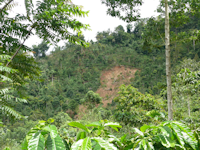 Landslide, West Lampung. Photo: J. Heyde |
Building on a literature-based review of existing watershed-related PES schemes in Indonesia (see Heyde et al. 2012), field research was conducted on four schemes in Indonesia: Brantas (East Java), RiverCare (West Lampung), HKM Community Forestry (West Lampung), Mendalam River (Kapuas Hulu, West Kalimantan). Empirical data was collected through a series of semi-structured interviews and group discussions with a variety of actors (farmers, intermediaries, beneficiaries, government, NGOs), and field observations. Additional field research was carried out in the HKM Community Forestry scheme in West Lampung in December 2013, aiming at a deeper understanding particularly of implementation processes and effects of the scheme at the community-level and related effects on land use. |
|
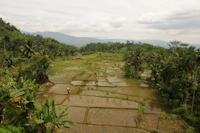 Terraced rice fields and mixed forest gardens in the catchment area of the Citanduy River. Photo: M. Lukas |
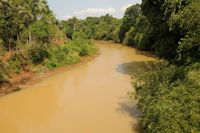 The Citanduy River, the main tributaryof the Segara Anakan lagoon. Photo: M. Lukas |
Analysis of empirical data is ongoing and to date has focused on obtaining a better understanding of the conditionality of PES schemes in Indonesia, where conditionality refers to payment (monetary or non-monetary) only being granted to providers of environmental services upon delivery of such services (see below). In addition to the focus on conditionality, the research also point to a number of other important issues that need consideration when designing and implementing PES schemes. These include: the importance of tenure clarity, questions of scale, the importance and challenges of measuring environmental impacts, the central role of parastatals and government in existing PES schemes in Indonesia, and the role of non-financial incentives. | |
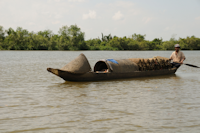 Fisher in the Segara Anakan lagoon. Photo: M. Lukas |
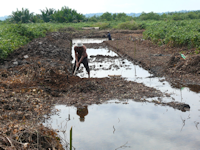 Opening new aquaculture pond, Segara Anakan lagoon. Photo: J. Heyde |
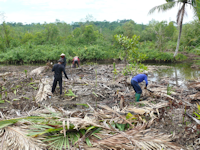 Planting mangroves, Segara Anakan Lagoon. Photo: J. Heyde |
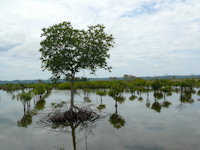 Aquaculture area with planted mangroves, Segara Anakan Lagoon. Photo: J. Heyde |
In the Segara Anakan Lagoon research is focused on better understanding the context within which new governance instruments aimed at sustainable management of the lagoon might be implemented. Research in the lagoon is nested within broader considerations of watershed management (see Lukas 2014 and Lukas et al. 2012). Of particular interest are questions related to changes in land and mangrove management over time, including how newly emergent land (from sedimentation) is viewed by different actors and how decisions are made regarding its usage. Empirical data has been collected through semi-structured interviews with farmers, fishers, different government departments, the national forestry corporation (Perhutani) and academics, complemented by field observations.Related Publications |
